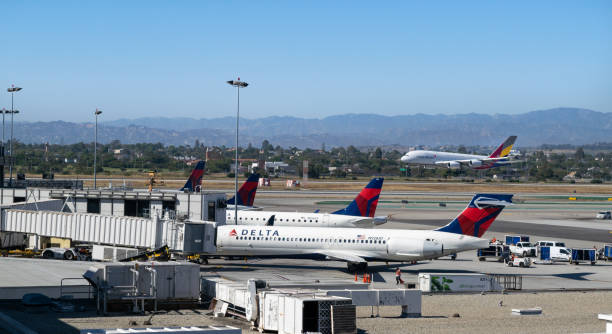Delta Flight DL275’s recent diversion to LAX has put Delta flight dl275 diverted lax the spotlight on just how quickly plans can change in the air travel world. For passengers aboard, what should have been a routine journey turned into an unexpected detour filled with uncertainty and inconvenience. As we dive deeper into this incident, we’ll explore not only the immediate impact on those affected but also broader implications for airlines and travelers alike. Buckle up; it’s time to navigate these turbulent skies together.
Outline for “Navigating Delays: How Delta Flight DL275’s LAX Diversion Affected Travelers”
Delta Flight DL275’s diversion to LAX came as a surprise for many passengers. What should have been a smooth ride turned into an unexpected pause, leaving travelers in limbo. The reasons behind this sudden change added layers of complexity to the experience.
As passengers grappled with the uncertainty, their immediate concerns revolved around logistics and comfort. Many faced missed connections, while others had to navigate crowded airport terminals waiting for updates on their journeys.
This incident serves as a reminder that air travel can be unpredictable. Understanding how these diversions impact not just travel plans but also emotions is crucial for both airlines and passengers moving forward.
Introduction
Travel disruptions can turn a simple journey into a logistical nightmare. Recently, Delta Flight DL275 faced an unexpected diversion to LAX that left many travelers in limbo. This incident not only affected those onboard but also had ripple effects throughout the airport and beyond.
Passengers expecting a smooth arrival were confronted with uncertainty, delays, and potential missed connections. The chaos at Los Angeles International Airport served as a reminder of how quickly travel plans can change due to unforeseen circumstances.
As we explore the details surrounding this incident, we’ll examine its impact on passengers, financial repercussions, technical aspects of the diversion, and industry reactions. Understanding such events is crucial for both travelers and airlines alike.
Delta Flight DL275 Diversion Overview
Delta Flight DL275, originally scheduled from Los Angeles to New York City, faced an unexpected diversion that left many travelers in disarray. The aircraft was forced to land at LAX due to inclement weather conditions en route. This situation led to delays and confusion among passengers, who were already anticipating their arrival.
Upon landing, the crew informed passengers of the diversion’s reason but did not provide immediate solutions for rebooking or accommodations. Many found themselves stranded at LAX with limited options available. Travelers had to navigate a busy airport without clear communication on what would happen next.
As news of Delta flight DL275’s diversion spread, frustration mounted. Passengers took to social media platforms seeking answers and sharing their experiences while waiting for assistance from airline staff.
Impact on Passengers
The diversion of Delta Flight DL275 to LAX caught many passengers off guard. As the plane touched down unexpectedly, confusion filled the cabin. Travelers were anxious about missed connections and unexpected layovers.
Upon landing, passengers faced long waits for updates from airline representatives. Many found themselves stranded at an airport far from their final destination. This added stress compounded frustrations as they navigated rebooking processes amid crowded terminals.
Additionally, some travelers experienced emotional distress due to uncertainty surrounding their travel plans. Families separated by the delay worried about reunions or important events they might miss. The ripple effect was undeniable—what should have been a routine flight turned into a chaotic day for countless individuals.
Financial repercussions
The diversion of Delta flight DL275 to LAX brought unexpected financial challenges for many passengers. Some travelers faced additional costs, including hotel stays and meals. These expenses can quickly add up, especially if the delay extends over several hours or even overnight.
Airline policies regarding compensation may not adequately cover these unforeseen circumstances. Passengers often find themselves navigating a maze of claims processes that can be confusing and time-consuming. While some airlines offer vouchers or refunds, their effectiveness varies widely.
Additionally, missed connections due to the diversion lead to further costs for travelers scrambling to rebook flights. The ripple effect on personal finances is significant and Delta flight dl275 diverted lax highlights a broader issue within the airline industry when it comes to passenger care during emergencies.
Technical Analysis of the Incident
The diversion of Delta Flight DL275 was primarily a response to an in-flight emergency. Preliminary reports indicated that the aircraft experienced technical difficulties, leading pilots to prioritize passenger safety above all else.
Investigators are now focusing on the specific systems involved during the incident. Understanding whether a mechanical failure or human error contributed will be key in preventing future occurrences.
Data retrieved from cockpit instruments and maintenance logs can provide insights into what went wrong. This analysis is crucial for airlines aiming to enhance their Delta flight dl275 diverted operational protocols and ensure a smoother travel experience moving forward.
Potential Preventative Measures
Addressing the challenges posed by unexpected diversions like Delta flight DL275 requires a multifaceted approach. Airlines should invest in advanced communication systems that keep passengers informed about real-time changes. When travelers have accurate information, they can better manage their plans and reduce stress.
Training staff to handle such situations effectively is crucial. Well-prepared crews can provide timely updates and empathetic support, ensuring passengers feel cared for during disruptions.
Enhancing technology for flight tracking could improve overall airline operations. Predictive analytics may help airlines anticipate potential issues before they escalate into significant delays or diversions, ultimately leading to smoother travel experiences for everyone involved.
Industry Reactions and Lessons Learned
The diversion of Delta Flight DL275 to LAX sparked varied reactions across the aviation industry. Airlines, regulators, and safety experts closely monitored the incident to gather insights into operational protocols during emergencies. Many expressed concerns about communication strategies between flight crews and air traffic control.
Airlines are now reassessing their crisis management Delta flight dl275 diverted lax approaches. The importance of timely passenger updates was highlighted as a core aspect of maintaining trust during unexpected events. Experts advocate for more comprehensive training programs that emphasize situational awareness among cabin crew.
Lessons from this event may prompt airlines to invest in advanced technology designed for real-time monitoring and decision-making support. Enhanced collaboration with regulatory bodies can also lead to improved safety standards across the sector, benefiting travelers at large.
Conclusion
The recent diversion of Delta flight DL275 due to unexpected circumstances has shed light on the complexities of air travel. Passengers faced not only the inconvenience of delays but also financial challenges, as many scrambled to adjust their plans and expenses.
This incident serves as a reminder for both airlines and travelers about the importance of preparedness in navigating such unforeseen events. The technical analysis points towards areas that can be improved, while industry reactions indicate a collective desire for better protocols.
As travel resumes its normal rhythm post-pandemic, enhancing communication and operational efficiency will be crucial for improving passenger experiences. Learning from incidents like this will help build resilience within the aviation sector moving forward.






Leave a Reply